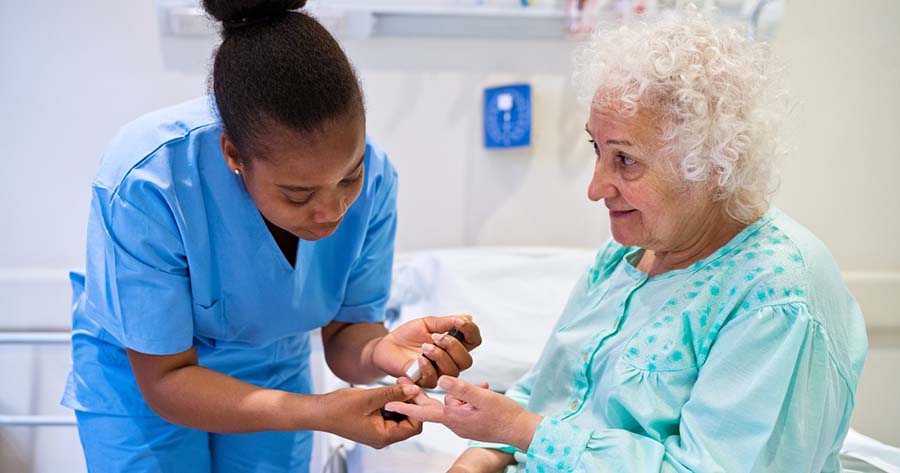It has been suggested that, in certain areas of care, the diabetes care offered to an older person with diabetes is no different from that offered to any other person with diabetes (Kirkland, 2001) and – quite rightly – that this leaves many specific needs unmet. The situation is likely to worsen with the estimated prevalence of diabetes set to rise considerably over the coming years, and an increase in the ageing population.
Meneilly and Tessier (1995) point out that as many as 20% of those over 65 years of age have diabetes. With an increasing number of people with type 2 diabetes being transferred to insulin, it would be naïve to ignore the fact that this may cause a significant problem in the future. Although these people can manage their sometimes ‘not so simple’ insulin regimens at present, there are no guarantees that they will be able to cope with them as they get older.
An ageing population
Population increases in the UK have not occurred at all ages: however, the proportion of the population aged over 65 years has increased from 13 % in mid-1971 to 16 % in mid-2003 (Office of National Statistics, 2004). The Government suggests that continued population ageing is inevitable during the first half of this century, mainly because of the large numbers of people born after the Second World War.
In Stockport alone, 15 % of our population is over the age of 65; thus, if the figure of 20% diabetes prevalence in this age group is correct, we have a potential ageing population with diabetes of 9200 people – a formidable number! Of course, not all of these are taking insulin for their diabetes, but approximately 50% of people with type 2 diabetes will be transferred to insulin at some stage in their lives, in order to improve metabolic control, reduce the risks of disability and mortality, slow down the progression of existing complications and – let us not forget – improve statistics for the General Medical Services contract!
Push to improve control of diabetes
Hendra and Sinclair (1997) found that type 2 diabetes was indeed often under-treated and under-managed, leading to a disproportionate amount of morbidity, disability and mortality in older people (Sinclair and Barnett, 1993). More recently, there has been a definite push to reduce disability and morbidity and improve metabolic control in all age groups, which has inevitably resulted in more people transferring to insulin therapy. At present, the number of people requiring help with insulin injections is relatively small; however, these figures are bound to rise as more older people with type 2 diabetes are transferred to insulin. This could pose a significant problem for already overstretched community nurses, who may find an indicative increase in the number of insulin-treated patients requiring help with injections on their caseloads.
Yet anyone who has experience of district nursing knows that it is not always simply a case of a few minutes to give the insulin injection. An older person who needs help with injections will inevitably require help with blood glucose testing, quality controlling their reflectance meters, assistance with other medication, etc. In addition, before leaving an elderly patient at home alone after an insulin injection, district nurses need to ensure that the person will be eating sufficient carbohydrate to balance the insulin just administered. So, what would initially appear to be a relatively short visit could take up to three- quarters of an hour or more.
I am sure many of us have agonised over whether to transfer a person in their 80s to insulin therapy, but often there is no other choice. Given the incredibly complex problems that many old people have – polypharmacy, multiple pathology, depression, living alone, poverty, to name but a few – this is not a decision to be taken lightly.
Millions overspent
The National Service Framework for Older People (Department of Health, 2001) states that health and social care services should treat older people as individuals and enable them to make choices about their own care, and that this should be done by, among other things, an ‘integrated provision of services’. However, it is difficult to see how this can be achieved in the present climate of underfunding and stretched existing resources. So, what does the future hold for the senior members of society who require insulin and help from professionals to administer this? It is difficult to say.
Many trusts have grossly overspent. The National Audit Office reported that, in 2002–2003, 51 organisations were £45 million in debt, mainly due to the cost of negligence claims, which amounted to £446 million. In the same year, three primary care trusts and seven NHS trusts reported in-year deficits of more than £5 million. In 2003, the Shadow Secretary for Health, Dr Liam Fox, is reported to have said that the situation had markedly deteriorated in the last year (BBC, 2003). No surprises there!
It seems unlikely then that there will be any money forthcoming to improve the plight of older people with diabetes who cannot manage the complexities of their treatments in the future. Forbes et al (2002) reported on the challenges in developing and evaluating healthcare inter- ventions for older people with diabetes, and highlighted how little is known about this patient group. Perhaps we need to get the measure of our older population with diabetes now, and to work out the best way to provide effective care for them, not just at the present time but also in the future, before the situation becomes too overwhelming to cope with.





Key scientific developments presented at the conference.
6 Aug 2025